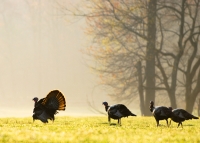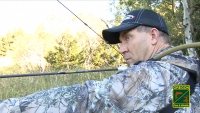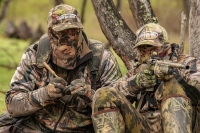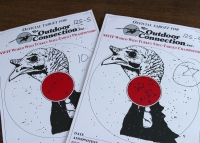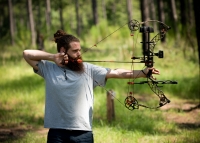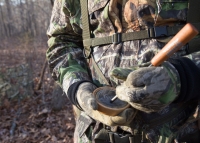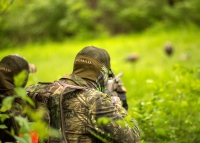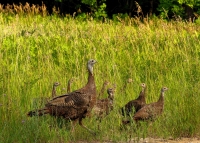
Gear and clothing for turkey hunting
Essential gear
You don’t need a lot of gear to hunt turkey – that’s one reason for its growing popularity. However, the more you hunt – in different seasons and in different parts of the state – the more you’ll discover there are some things that can make you a more comfortable and successful hunter.
Here are some essential pieces of gear beginning turkey hunters will want to consider:
- A face mask or camouflage face paint. Turkeys have keen eyesight so you’ll want to cover your entire face and neck with something camouflage that’s comfortable to wear. Bowhunters often prefer camo face paint that won’t get hung up in the bow string like some masks can.
- Gloves or camouflage paint for your hands. Same reason as above.
- Something to sit on. It could be a simple pad if you’re shotgun hunting from in front of a tree, to a small stool if you’re bowhunting from a ground blind.
- A ground blind to help hide any movement that might spook a turkey. Ground blinds are almost essential for beginning bowhunters. It’s hard to draw back a bow without moving at least a little. At the same time, shotgun hunters also will enjoy the comfort and effectiveness of hunting from a ground blind.
- A pair of binoculars to spot turkeys, and to measure the length of their beards. Binoculars also can help you study the terrain and plan your next move.
- A rangefinder, if you’re a bowhunter. When it comes to accuracy, knowing the distance to your target is critical. A decent rangefinder should be at the top of any bowhunter’s check list.
- Proper clothing. This includes clothing appropriate for the weather, and a camouflage pattern that matches the seasonal vegetation.
- Suitable boots for walking in or for following birds.
- A valid hunting license and turkey tag.
- Turkey calls.
- Turkey decoy(s) (optional).
- Knife and rubber gloves for field dressing your bird.
- Food and water for a day in the woods.
- First aid kit.
- Toilet paper and wet wipes.
- A pack or turkey vest to carry everything in.
Optional items as you hunt more
The more you turkey hunt, the more you’ll learn what gear you need for your specific style of hunting. Some of the most popular “bonus” gear includes:
- Trail cameras. A useful tool for scouting before the season, or for monitoring turkey activity during the season. Trail cameras are your eyes in the woods when you’re not there, and can reveal turkey numbers, age range, and when they’re moving.
- Knee pads. If you need to stay low and crawl into position to setup and call in a turkey, knee pads will keep you dry and protect you from sharp rocks and sticks.
- A shotgun rest. A knee pad shotgun rest will let you sit comfortably at the base of a tree with your shotgun up and in the ready position. This will minimize your movements if a turkey approaches and you need to take a shot.
- A bow stand. Properly placed by your chair in a ground blind, a bow stand holds your bow in the ready position, making it easier to grab your bow and get ready for the shot.
Clothing considerations
As with all types of hunting, it’s important to choose the right kind of clothing for turkey hunting.
Early in the spring turkey season, conditions can be very cold and wet compared to later in the season. At the same time, higher elevations may be colder than the valley floors.
The fall turkey hunting season also offers a wide-range of weather conditions, in a variety of places. The weather in October can be very different than conditions in late December. This means proper clothing is important no matter what time of year or where in the state you’re hunting.
Layer clothing for changing conditions
For turkey hunting, layered clothing is a good place to start. You can encounter a variety of weather conditions during a day of hunting – from early morning frosts to warm, sunny afternoons. Being able to add or remove a layer of clothing as conditions change will let you be comfortable throughout the day.
- Start with a base layer that wicks moisture away from your body. Avoid cotton – it’s comfortable but once it gets wet with sweat it will feel clammy and cold. Choose a top and bottom made of wool or a moisture wicking synthetic fabric.
- The next layer of clothes should be lightweight and breathable to keep the moisture moving away from your body. Synthetic active wear is ideal, just make sure it isn’t so snug that it inhibits air flow between it and the base layer.
- Top it off with an outer layer that is made from a warm, waterproof and wind-stopping fabric. On cold days, an insulated rain jacket will help block the wind even if it’s not raining. On warmer, rainy days, a waterproof shell may be all you need for an outer layer.
Having two pairs of camouflaged gloves can be “handy.” One pair can be thin, the other insulated and waterproof. When one pair gets wet and your hands get cold, you’ll appreciate having a backup pair. Disposable hand warmers will also be welcome on those chilly morning hunts.
Finally, on cold days a beanie or other hat will reduce heat loss and help keep your comfortable.
Look for fit and comfort
Be sure to try on all your clothes before heading afield. Make sure your layers of clothes fit properly, are comfortable and let you move freely. At the same time, make sure your clothes aren’t so big that they sag or flap around in the wind, causing unnecessary movement and noise that could spook a bird. Also, you’ll be walking through brush, drawing a bow or raising a shotgun, and don’t want overly large clothes getting hung up on anything.
The quality of hunting clothes has never been better. Take the time to find what materials are most comfortable and perform the best. Be sure to select clothes that match the conditions in which you’ll be hunting, and your style of hunting. If you have a short walk and will be sitting in a ground blind, you can wear heavier, warmer clothes than if you're hiking in the mountains and sweating from exertion.
Being comfortable in the turkey woods is important because the more comfortable you are, the longer you can hunt.
Footwear
It’s hard to enjoy a day of hunting if your feet are cramped, wet or cold. Many turkey hunters in Oregon have at least two different pairs of boots to meet the variety of conditions they might encounter while hunting.
Rubber boot for cold, wet conditions
Rubber knee boots are a good choice when conditions are cold and wet, and/or when you’ll be sitting for hours in a ground blind. Many boots are insulated to help keep your feet warm. If you’re looking at uninsulated boots, buy them ½ to one size larger than you normally wear. This will give you room to wear a pair of thick, warm socks with them.
Disposable toe warmers or electric socks also will help keep your feet warm when you’re sitting for hours in a ground blind.
Hiking boots when it’s warm and dry
Quality hiking boots are the better choice in warm, dry conditions and/or when you’re going to be covering some ground to locate turkeys. Opt for waterproof boots to keep your feet dry while crossing streams or other wet areas.
Never wear your boots for the first time on a hunting trip. Instead, break them in prior to the season so you know they fit properly and what socks you should wear with them.
Gators over your hiking boots can keep snow or grass seeds from getting into your boots.
The more time you spend turkey hunting, the more pairs of boots you might acquire. Once you’ve hunted in 20º temperatures in the snow, or in 80º temperatures in the dry, blazing heat -- and once you’ve found yourself traversing creeks, wet, grassy fields, brushy hills and clearcuts -- you might find you want an additional pair of boots for specific types of weather or habitat.
Packs and vests
You’ll need a way to carry your shells, turkey calls, first aid kit, extra gloves, lunch, water and other gear into the field. The most popular choices are a daypack or a specialized turkey hunting vest.
Daypacks are simple and affordable
A daypack is a simple and affordable option. It will hold a lot of stuff, most have some pockets to help you organize your gear, and some are hydration bladder compatible to help you stay hydrated during hot, dry hunts.
Keep these things in mind when packing a daypack:
- Make sure the things in your daypack are secure and don’t shift, rattle or make any noise.
- Put you most-used items (calls, shells) in easily accessible places like pockets or on the top of the main compartment.
- Include a cushion to sit on. Sometimes it’s easiest to strap this to the outside of the pack.
Specialized vests are most efficient
If you’re going to get serious about turkey hunting, consider a specialized turkey hunting vest.
Each pocket of a turkey vest has been designed for a purpose. Some pockets hold box calls, some hold pot calls, others hold strikers and locator calls. Some vests even feature mesh pouches to hold diaphragm calls that allow proper airflow for the calls to dry out after use.
There are pockets and pouches for knives, shears, shotgun shells and much more, and they are designed to keep gear secure so it’s not moving around creating wear and unwanted noise.
There also are larger pockets for extra gear and a game pouch that can haul lunch and water -- maybe even your bird. Some also are hydration bladder compatible.
The amount of gear a turkey hunting vests can hold is surprising, making it an efficient system as you start to accumulate more gear each season.
One of the best features of a good turkey vest is a built-in padded cushion to sit on. It won’t take too many hours of sitting on the ground to appreciate having a cushion conveniently on hand.
Be sure and try on multiple vests to see which one you like the best. Make sure you can easily operate the seat pad and access all the pockets. There are several designs when it comes to turkey vests, so find one that meets your needs and feels most comfortable. You may be wearing it for many seasons to come.
Fanny packs for traveling light
For shorter hunts, a large fanny pack may be enough. Simply add what essential gear you’ll need for a brief hunt, and you’re set. If you’ll be sitting on the ground, it’s worth carrying a cushion to sit on. If you’re also carrying carrying a cushion or turkey decoy on your hunt, you might want a sling for your shotgun or bow to help free up your hands.
One final tip: Take a hike
Before heading out on a turkey hunt, try on your vest or pack, grab your gun or bow, and go on a hike. Make sure everything fits snugly, and that calls and gear aren’t moving around and making noise. Get comfortable with working your turkey vest or pack, and practice setting up with all your gear on. Practice drawing your bow and shouldering your shotgun. When it comes time to hunt, you should be comfortable and confident in your gear.
Safety gear
While turkey hunting is one of the safest forms of hunting, there are some safety tips hunters should follow.
Be visible when you need to be
The biggest risk in turkey hunting is being in the woods with other turkey hunters. Remember, everyone will be wearing camouflage and sounding like a turkey as they try to call in birds (including you).
Therefore, you’ll want to make sure you and your location are visible while you’re walking to the blind or setting up, while you’re set up behind a tree and while you’re carrying your bird out of the field.
A roll of blaze orange flagging tape and/or a blaze orange hat can help you stand out when you need to.
Consider wearing a blaze orange hat or other something while walking into or out of a hunt. Some turkey vests have a built-in blaze orange panel that can be revealed when you’re moving through the woods and dense brush.
Tie flagging tape to the turkey you’ve harvested so other hunters don’t think the bright red, white and blue head belongs to a live bird (it’s happened).
Finally, use tape to mark your trail or hunting spots. Some turkey hunters who have set up in front of a tree like to hang something bright red or orange on the opposite side of the tree so other hunters know they’re there. Popular choices include a hat, bandana or flagging tape.
Other safety gear: navigation, first aid and more
There is always an element of risk when you venture off-trail – even for a short hunt. Every hunter should be prepared to deal with minor injuries, getting lost and unexpected changes in the weather.
To start, let someone know where you are going and when you plan to return. If you’re seriously overdue, they can call for help. (For this reason, also let them know when you've gotten home safely.)
In addition, be sure to carry the following:
- A GPS unit or map/compass so you can find your way back
- A first aid kit, with blister treatment and antihistamine for bug bites
- Plenty of food and water
- Sunscreen
- Lip balm with sunscreen
- Insect repellent
- Poison oak ointment
- Rain gear

